The HTC One X for AT&T Review
by Brian Klug on May 1, 2012 6:00 PM EST- Posted in
- Smartphones
- Snapdragon
- HTC
- Qualcomm
- MSM8960
- Krait
- Mobile
- Tegra 3
- HTC One
- NVIDIA
Javascript Performance
Although smartphones are clearly headed for a life beyond simple messaging, web browsing and phone duties, we are still lacking the tools to measure performance in areas other than a component of web page rendering. Measuring javascript performance is one component of the entire web page rendering process but it's the most mature in terms of something we can benchmark.
Sunspider is quite possibly the most well known of these javascript tests:
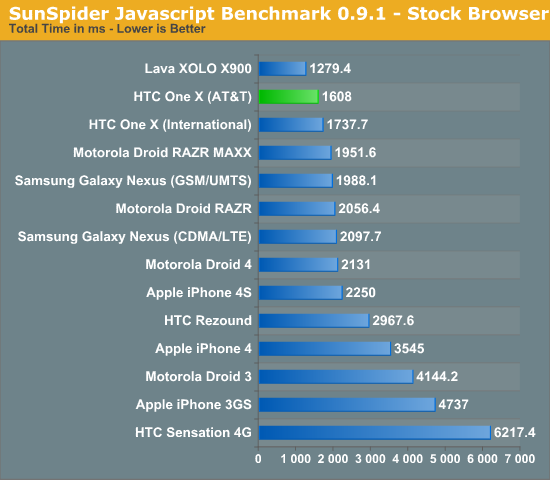
We expected Snapdragon S4 to do very well here based on our preview numbers and it did not disappoint. Although it's not quite as fast as Intel's Medfield, it's clearly the fastest smartphone SoC in this test otherwise. It's worth noting that HTC is able to deliver performance that's within 5% of Qualcomm's Snapdragon S4 MDP, a significant improvement over where things were last year.
The Sunspider test makes good use of 1 - 2 cores but there are times when it'll stress all four on a Tegra 3. For the most part however, NVIDIA's extra cores go unused in this benchmark. Krait and HTC's ICS browser definitely offer a significant advantage over the performance of the ICS launch vehicle, Samsung's Galaxy Nexus. This is honestly the hardware that Google should have used as the basis for its Nexus platform, it's too bad that it wasn't available at the end of last year.
BrowserMark is another js benchmark in our suite:
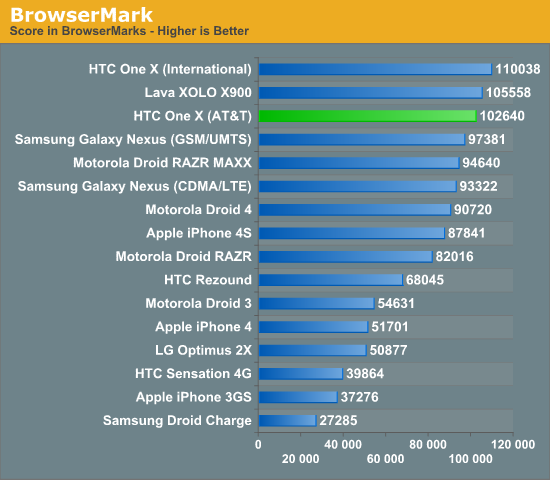
Here the international and AT&T One Xes trade spots as Tegra 3's extra cores are able to give it the slight edge in performance. Once again we're talking about the fastest smartphones in our test suite.
Low Level FP Performance
Linpack isn't a great indication of smartphone performance, but it is a good test of the floating point capabilities of the CPUs in these SoCs. ARM has steadily been improving FP performance for the past few generations but we're going to see a big jump to Krait/A15. As most client smartphone workloads are integer based and those that are FP heavy end up relying on the GPU, an advantage here doesn't tell us much today (particularly because Linpack isn't running native code but rather atop Dalvik) other than how speedy the FPUs are:
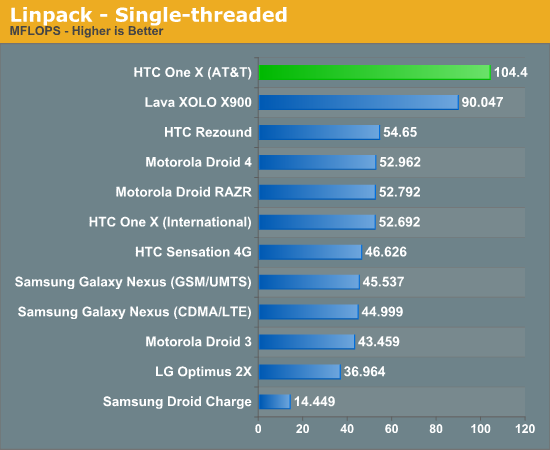
Improved single threaded FP and memory performance is something we get with Krait, and it's demonstrated quite well by the AT&T One X. While you're unlikely to see this magnitude of an advantage in most real world smartphone workloads, this is an architectural advantage of Qualcomm's Krait that's worth mentioning. However these days most FP intensive workloads on smartphones are handled by the GPU, making this performance advantage mostly academic at this point.
Linpack, like many scientific workloads, scales up to multiple cores quite nicely. If we spawn as many threads as there are logical cores (2 for Intel and Qualcomm, but 4 for NVIDIA's Tegra 3) we can see how these SoCs fare in a multithreaded world:

BaseMark OS
Rightware's BaseMark OS is a general purpose benchmark designed to better simulate overall Android performance. It includes a heavily threaded benchmark, file IO tests, and compression/decompression tasks that all contribute to its overall score. We only have results from the HTC One S/AT&T One X (Snapdragon S4), One X (Tegra 3), Galaxy Nexus (OMAP 4) and the Lava phone (Medfield) here:
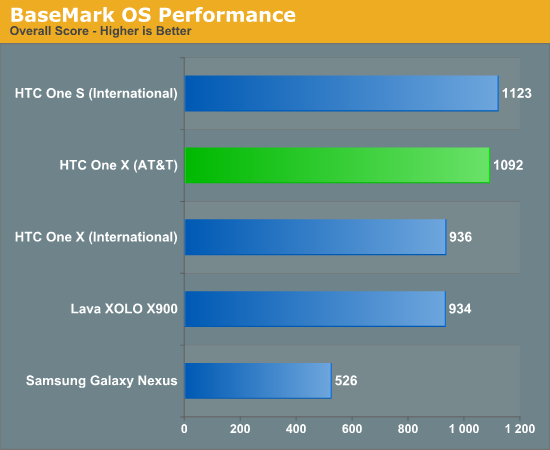
As expected, the AT&T One X does very well in this general purpose, OS-level benchmark. The device significantly outperforms Samsung's Galaxy Nexus, which isn't a surprise given how dated the hardware was at the time of launch. Again the magnitude of advantage is likely exaggerated by this benchmark, but there's no changing the fact that HTC makes the fastest Android smartphones on the planet for now.
Note that the performance difference between the two One X models is likely exaggerated by BaseMark OS as well. In our regular use we found the two to be fairly similar in performance, with the slight edge going to the AT&T One X but not by a huge margin. You'd be hard pressed to tell these two apart.
Vellamo
Vellamo is a Qualcomm developed benchmark that focuses primarily on browser performance, both in rendering and UI speed. The results are heavily influenced by the browser used on the device being tested. As a whole Vellamo isn't always indicative of whether or not you're going to get a smooth browsing experience, but it's another datapoint that captures more than just javascript performance. The Qualcomm-developed nature of the benchmark is always cause for concern, but even if you exclude the Snapdragon results the benchmark can be useful:

Qualcomm's SoCs have always done very well in this Qualcomm-built benchmark, but the results still echo what we've seen in practice. The AT&T One X definitely feels like the fastest Android phone we've used, especially compared to much of what was available last year. The gap between the international and AT&T One X versions is, once again, debatable. The Qualcomm performance advantage is at times perceivable, but I wouldn't consider it to be significant at all.
Flash Rendering Performance
These days nearly all high-end smartphones (I refuse to call them superphones) can render Flash smoothly. The HTC One X is no exception. We're basically at vsync here and will have to move to either more stressful flash content to test or just accept that flash is already performant enough.

GPU Performance - GLBenchmark 2.1
As we wait for actual 3D gaming benchmarks to make their way into Android (and hopefully crossplatform) games, we must rely on synthetic tests designed to simulate 3D game performance as best as possible. We start with GLBenchmark, one of the better Android GPU tests on the market today. There are two benchmarks, Egypt and Pro, and each is run in two modes: native screen resolution and offscreen (vsync disabled) at 720p. The latter is more useful for apples to apples comparisons as everything is rendering the same number of pixels, whereas performance in the onscreen tests is determined by the screen resolution of the device along with the performance of its GPU.
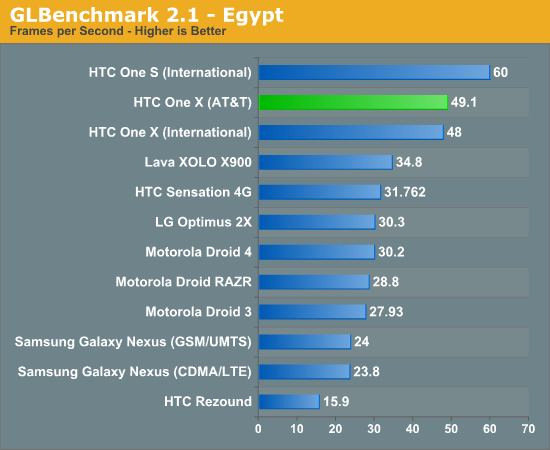
Part of the deal in getting Krait to market as quickly as possible required that Qualcomm pair the CPU with an older GPU, in this case the Adreno 225 instead of the newer Adreno 3xx offerings due out later this year. As a result, the AT&T One X can take a back seat to the international One X in GPU performance. When not limited by v-sync, the Tegra 3 based international One X is about 12% faster than the Qualcomm S4 based AT&T One X. For most gaming however, you'll be hard pressed to notice a performance difference.
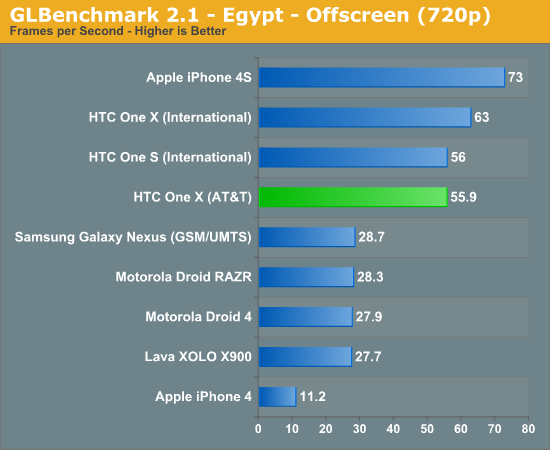
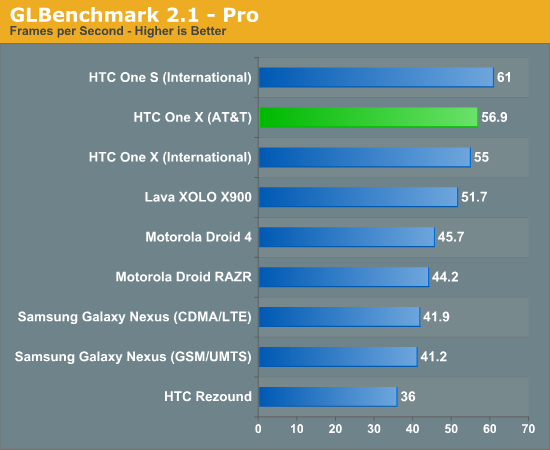
The Pro offscreen results actually flip flop a bit with the AT&T One X leading the international version. Once again, limited by v-sync (onscreen results) the two are basically identical performers.
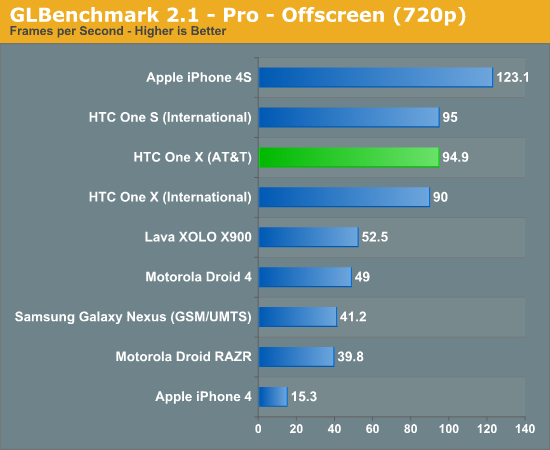
Basemark ES 2.0 V1
Rightware's Basemark ES 2.0 V1 is an aging GPU test that tends to favor Qualcomm's Adreno GPUs above almost all others:

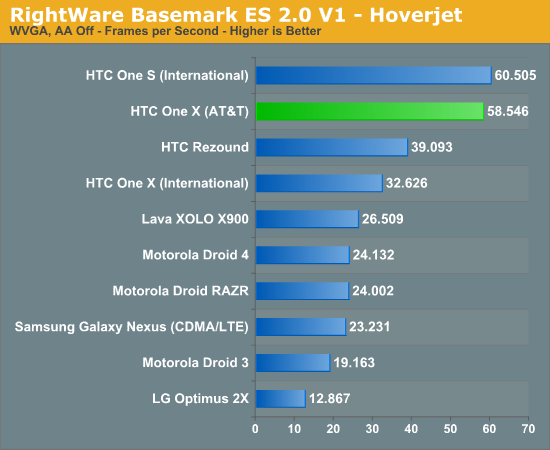
We're not surprised to see the AT&T One X do so well here as it appears Qualcomm has done quite a bit of optimization work for this particular benchmark. I wouldn't put too much faith in these numbers other than to show you an example of just what can happen with a good amount of optimization on behalf of a hardware vendor.










137 Comments
View All Comments
Stormkroe - Tuesday, May 1, 2012 - link
The normalized portions is strictly for showing the efficiency of the phone as a whole package. In the case of the One X and XL, we get a rare opportunity to compare efficiencies without worrying about software, screens, battery manufacturer, etc, as they are all identical. We're then left with a pretty good grasp of how the S4 SoC compares to the Tegra3 SoC, as apples to apples as it's going to get. I'd suggest that maybe it's time you just started skipping over that part if you can't understand the relevance.sprockkets - Tuesday, May 1, 2012 - link
What about MHDL? What resolution does it output at?3DoubleD - Tuesday, May 1, 2012 - link
How come there wasn't any comment on the ludicrously small storage space on this phone? How is 16 GB of flash acceptable in a TOP END Q2 2012 phone?!?This thing costs well over $600 and we only get 16 GB of flash! How much does slow NAND cost? Would an additional 16 GB of storage really cut into the bottom line? How about making 64 GB standard? High performance SSDs are going for $1/GB, and the NAND in these phones is no where near that performance level... food for thought.
Why must HTC play down to Apple's level, then yet provide none of the upgrade options (which are in themselves insulting in a $600+ phone)?
weiln12 - Wednesday, May 2, 2012 - link
I agree completely here.I really don't care if there's expandable memory, I hardly (if ever) used it, I simply use DropBox now if I need to. However, I have over 12GB of music that I listen to every day. How in the heck do these Android phones get by with only 16GB of TOTAL space available?
I use a 32GB iPhone now, and part of me misses Android. However, as long as these "top-end" phones only have 16GB of memory, there's no way I can use them. It's a shame, because I'd really love to have a faster phone and better camera...but I can't give up listening to music.
metafor - Thursday, May 3, 2012 - link
Google music :)3DoubleD - Thursday, May 3, 2012 - link
The problem with stream music is that the majority of phone planes have data caps. Also, streaming music is more battery intensive than just playing local music files.Also, the way the partitions are for the One X, you only have 2 GB for apps, which is perhaps just enough for heavy users today; however, apps are getting bigger, not smaller. I suspect that 2 GBs of app storage space will be too small for a large number of users during the reasonable lifetime of this phone (next 2-3 years). If anything, they should have made it 3 or 4 GB, but then the insanely small amount of room for pictures and video storage would be a limiting factor. Their real problem is they were just too ridiculously stingy with the amount of integrated flash and it's a real shame because this is a beautiful device.
Goi - Tuesday, May 1, 2012 - link
Why is it that the One S performs better than the AT&T One X when they both use the same SoC?Impulses - Tuesday, May 1, 2012 - link
Lower res display, less pixels to drive.Goi - Wednesday, May 2, 2012 - link
Thanks...I could've sworn I saw the One S leading in non-GPU results as well, but a quick check shows that I remembered wrongly...Stormkroe - Tuesday, May 1, 2012 - link
Screen res, broseph. The one S is pushing less pixels.